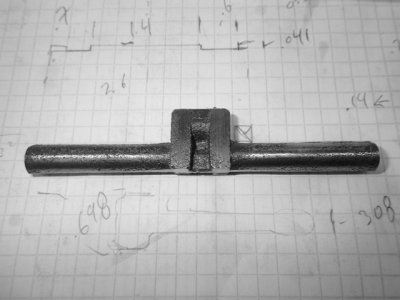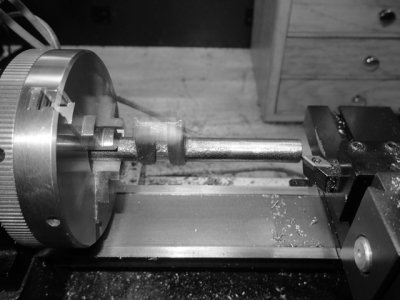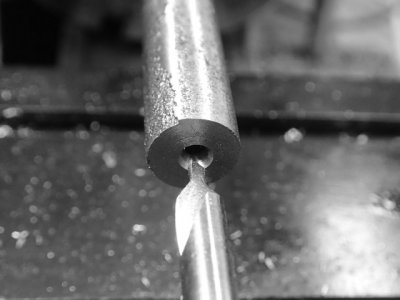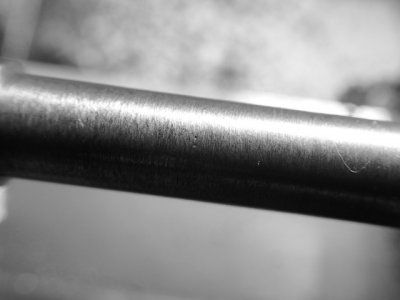-
Welcome back Guest! Did you know you can mentor other members here at H-M? If not, please check out our Relaunch of Hobby Machinist Mentoring Program!
You are using an out of date browser. It may not display this or other websites correctly.
You should upgrade or use an alternative browser.
You should upgrade or use an alternative browser.
Any Tips For Machining A Small Cast Crankshaft?
- Thread starter tomw
- Start date
T
TOOLMASTER
Forum Guest
Register Today
crankshaft grinders are fun to watch..
4
4GSR
Forum Guest
Register Today
I would have thought of using steel for a crank shaft or even ductile iron, but cast iron? I remember making one back when I was 12 years old on dad's 9" SBL that was made from a old bolt. Came out ok. Went back later and tried to fix it up a little and messed it up! Never did try to make another one after that.
- Joined
- Jan 24, 2015
- Messages
- 239
I received the replacement crankshaft today. Here it is after some initial filing and sanding:

I noticed immediately that this was a much softer material. I could easily remove the casting flash with my 1" belt sander, and finish up with a file. I had to use a carbide bit in my Dremel on the previous piece.
So, I mounted one end of the crank in a 3 jaw chuck, faced the opposite end, and center drilled that end.


I secured the tail end with a center. I then used a carbide bit to remove 30 thou, in two 15 thou passes, which got rid of the rough casting surface. The surface was still a bit rough. But the cut did not make me think of banshees, and a spring pass was uneventful. The material cut like CI I have cut before.
Below is the surface after a few few strokes with a file.

It is still ugly. But this was a rough cut, without trying to make things smooth. I am really happy with the result.
Thank you all for your help.
Cheers,
Tom

I noticed immediately that this was a much softer material. I could easily remove the casting flash with my 1" belt sander, and finish up with a file. I had to use a carbide bit in my Dremel on the previous piece.
So, I mounted one end of the crank in a 3 jaw chuck, faced the opposite end, and center drilled that end.


I secured the tail end with a center. I then used a carbide bit to remove 30 thou, in two 15 thou passes, which got rid of the rough casting surface. The surface was still a bit rough. But the cut did not make me think of banshees, and a spring pass was uneventful. The material cut like CI I have cut before.
Below is the surface after a few few strokes with a file.

It is still ugly. But this was a rough cut, without trying to make things smooth. I am really happy with the result.
Thank you all for your help.
Cheers,
Tom
- Joined
- Jun 7, 2013
- Messages
- 10,450
I think the amount of clearances you are using on your HSS cutting tool is quite excessive, this leads to a weak cutting edge that is more apt to burn or chip off. using a large radius will create chatter and also the angle of the tool to the work can exacerbate the chatter, it should be a little less than 90 degrees or near perpendicular to the work; the more angle, the wider the width of cut, increasing the tendency to chatter. I have machined both cast cranks (100-70-03 ductile iron) and steel cranks, both two throws @90 deg. for compound steam engines, these had 1-3/8" dia. journals and were about 30" long overall. If there is a secret to success, it is to run at slow speeds. All the turning was done between centers, a steady rest was used for the machining of the main bearings, but for machining the throws, that was not possible. The shafts were roughed out all over, semi finished on the diameters, finished on the lengths, then sent out for final grind finishing.
- Joined
- Jun 17, 2016
- Messages
- 108
Ok if I am way out of line please tell me as I am very green, but why are you trying to do this between
centers why can't you chuck one end in a 3 jaw as close to the cam as possible then turn and do the other half? Seems to me that would be a much more stable.
That is exactly how I would rough it out. You may not be below the 'skin' of the casting yet and mainly rubbing bits off?
It's a long thin piece of material for such a small lathe, balancing opposite side of crank-pin area will allow rpm to be maintained but without balancing I would be pretty nervous over 200 rpm. Vibration is surprisingly bad when even a relatively small piece of cast iron is hanging out on middle of a shaft, it's noticeable on a twin cylinder camshaft with 90 degree phasing on a small machine
Wish I'd read to end of page one before jumping in

As mentioned, you may try annealing as you have nothing at all to lose. Barbecue should work if you have enough ash to prevent surface cooling too quick. Chill cast iron can be damn hard stuff to do anything with, even on industrial machines if your not expecting it
Last edited:
- Joined
- Mar 3, 2017
- Messages
- 804
Thanks folks the ideas! I thought this idea from radon.com was quite interesting:
Yow, that looks exciting. If 'twere my problem, I'd make a cast out of plaster-of-paris to perform
that function ( a little hot water and vinegar, it'll come right off afterward).
Imho the lathe used is to light and speed to slow to use carbide. Try hss and check tool height and chuck crank in 3jaw, as far as possible. Make light passes to make round, turn shaft to put round cut side in chuck, center drill and cut new side close Also check runout of 3jaw before starting, any runout will cause wobble, use 4jaw or collets. Shorten tool overhang, attach piece of metal opposite crank journel to approximate balance of shaft. Make sure metal piece is secure enough not to move or fly off!! Files suck, I would leave enough to grind to spec, dremels are nice! The rod journal is another story! Take your time, make a precision part. This is what I would do, others can add to this, good luck, be careful!
